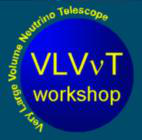Orateur
Prof.
Herbert Loehner
(KVI, University of Groningen)
Description
For the KM3NeT neutrino telescope an optical module with a number of small phototubes (multi-PMT optical module) will be advantageous for various reasons, e.g. reduced background rate, a larger number of coincidence hits and ultra-high neutrinos can be detected. The properties of such a design have been investigated by measurements and simulations. Several types of 3” PMT were exposed to LED light pulses with intensities down to the single-photon level. A small transit time spread was found for the 10-stage XP53B2 tube which is therefore proposed for the KM3NeT setup. At the same time an excellent peak-to-valley ratio of 3.9 was observed. The simulation tool Sirène for a photo-sensor based neutrino telescope has been applied to allow a comparison with the ANTARES detector. With a coverage of almost 4*pi sr, all muon directions can be observed with an improved identification and rejection of atmospheric muons. Although the symmetric angular coverage results in a smaller fraction of the photocathode area detecting up-going neutrinos, the superior quantum efficiency available for 3" PMT compensates for this effect. Cherenkov photons produced by muons as well as photons from electromagnetic showers arrive close in time and are well suited for track reconstruction. For up-going neutrinos and down-going muons the multi-PMT arrangement shows a better performance in both the photo-electron response and in the number-of-hits response as compared to the present ANTARES design.
Auteur
Prof.
Herbert Loehner
(KVI, University of Groningen)

